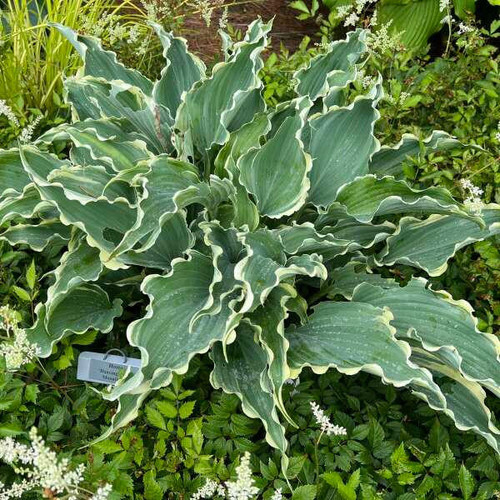Product Description
Hosta 'Dancing Queen' (Terpening 2005) (20)ct Flat
We are thrilled to be able to offer this exceptionally unique large, yellow hosta from Kent Terpening. Unlike other yellow hostas which emerge or turn chartreuse, ‘Dancing Queen’ emerges bright yellow and remains yellow all season long. The large leaves have a prominent pie crust edge, adding even more pizzazz to this colorful hosta.
In mid to late summer, the foliage lightens to soft yellow, and the clump is topped with pale lavender flowers. This one is a must-have! Parentage: H. 'Split Personality' x unknown.
2020 Hosta of the Year
Height: 18 Inches
Spread: 30 Inches
Scape Height: 28 Inches
Hardiness Zones: 3,4,5,6,7,8,9
Flower Color: Purple shades
Foliage Color: Yellow shades
Part Shade (4-6 hrs. Direct Sun) to Full Shade (< 4 hrs. Direct Sun)
Average to Consistent Water Needs
Average to Fertile Soil Quality
Bloomtime: Late Summer
Attracts Hummingbirds
Growth Rate: Rapid
Border Plant, Container, Cut Foliage, Easy To Grow, Mass Planting, Specimen, Focal Point
Hosta 'Dancing Queen' is a vibrant and eye-catching hosta cultivar that lights up the shade garden with its bright golden foliage and rippled edges. It is a large hosta with a moderate growth rate and adds a touch of sunshine to any shady spot. Here is a closer look at its key features:
Appearance:
- Golden Yellow Leaves: 'Dancing Queen' emerges in spring with bright yellow, wedge-shaped leaves that have a distinctive rippled or "piecrust" edge. The leaves can reach up to 13 inches long, creating a bold and textural effect.
- Pale Lavender Flowers: In midsummer, it produces pale lavender flowers on 28-inch scapes (stalks) that rise above the foliage.
- Mounding Habit: It forms a graceful, mounding habit, typically reaching about 1¼ to 1½ feet tall and 2½ to 3 feet wide.
Growing Conditions:
- Shade: Thrives in partial to full shade. It prefers some shade during the hottest part of the day to prevent the leaves from scorching and maintain their bright yellow color.
- Moist Soil: Prefers moist, well-drained soil that is rich in organic matter.
- Hardiness Zones: Suitable for USDA hardiness zones 3-8, making it a versatile choice for many gardeners.
Care:
- Watering: Water regularly, especially during dry periods, to keep the soil consistently moist.
- Fertilizing: Fertilize in spring with a balanced fertilizer to promote healthy growth.
- Mulching: Mulching around the plant helps retain moisture and suppress weeds.
- Dividing: Divide clumps every few years in spring or fall to maintain vigor.
Uses:
- Shade Gardens: Adds a bright and cheerful focal point to shade gardens.
- Borders: Can be used as a border plant to illuminate shady areas.
- Specimen Plant: Its unique foliage makes it a great choice for a specimen plant in a container or a special spot in the garden.
- Woodland Gardens: Blends beautifully into woodland gardens, adding a touch of sunshine.
Additional Information:
- Slug Resistance: 'Dancing Queen' exhibits some resistance to slugs, a common pest for hostas.
- Parentage: It was developed by Kent Terpening using Hosta 'Split Personality' as the seed parent.
- Unique Foliage: The bright yellow, rippled leaves of 'Dancing Queen' make it a standout in the shade garden.
If you are looking for a hosta with vibrant golden foliage, a unique texture, and a cheerful presence, Hosta 'Dancing Queen' is an excellent choice. It is a beautiful and low-maintenance addition to any shade garden.
Other Details
The most important part of the plant is its root system. Healthy roots are the foundation of a healthy, vibrant plant. The type of plug container used is based on the specific needs of the plants. Perennials offered as bare root traditionally perform better when planted as bare root.Planted in a specialized mix, potted plants have well established root systems. Top growth stage will vary depending on the current life cycle and time of year when shipped. In Winter and early Spring dormant plants may be shipped. Dormant plants may be planted right away, even before the last frost date.
Most bare root varieties are field grown for at least one season, though Hemerocallis and Hosta are grown for two seasons. The bulk of the soil is removed during the harvesting process and the tops of most varieties are trimmed back to the crown. They are graded, packed in shredded aspen or sphagnum moss and stored in freezers until ready to be shipped.
See our Container Sizes and Bare Root Perennials pages for more information.
Plant information and care is provided in the Overview section, Plant Genus Page and general information is provided in the Planting Care & Guides. Additional questions can be asked on each Plant page.
Plant Spacing: Using the maximum mature spread or width of a plant to guide spacing, ensures space to grow to full size. To fill an area sooner, plant them closer together. Just remember, future thinning or transplanting may be needed.
Water: Keep a close eye on newly planted perennials, especially throughout the first growing year. Most early plant loss is due to too much or too little water!

















